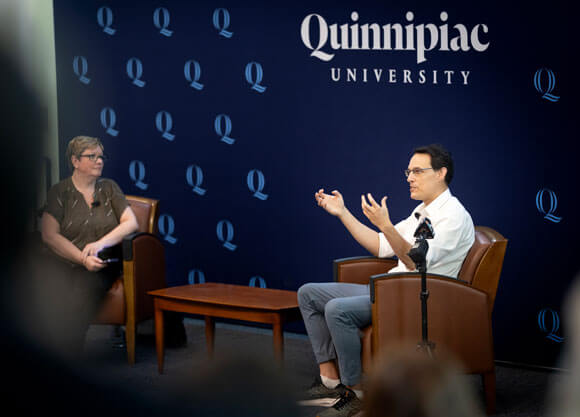
Political analyst Steve Kornacki shares ‘big board’ insights during Critical Conversations Speaker Series
October 08, 2024

October 08, 2024

Kornacki brought his expertise and knowledge to Quinnipiac as a guest of the 2024 Critical Conversations Speaker Series on October 7, discussing “The Story Behind the Stats: Media, Data and the Future of Political Coverage.” During the hour-long conversation moderated by Lisa Burns, professor of media studies, Kornacki answered questions about a wide range of topics concerning today’s current political environment and shifts in voter trends, before answering questions from students in the packed audience.
“It is often said that our differences are so profound that we are watching in real time the demise of the American community," said David Fryson, interim vice president for equity and inclusion, during his welcoming remarks. "The Critical Conversations Speaker Series is an example of how we can change the narrative on this campus community and perhaps assist in moving the national needle in establishing a new normal of respectful and meaningful dialogue. As we enter into the national elections next month, information is an important element in establishing that new normal.”
Kornacki is a national political correspondent for NBC News and MSNBC, reporting on the latest political developments across all platforms. Kornacki consistently provides real-time analysis of voting patterns, exit polls and electoral data.
Throughout the discussion, he emphasized the importance of translating numbers and statistics into a narrative that is understood by the public. He described his role as not just analyzing data but helping audiences make sense of how trends, polling data and historical voting patterns influence election outcomes. This skill has made him a go-to source during critical moments in American elections. It’s also why he’s gained a level of stardom few have seen among political enthusiasts.
“Yeah, it’s been a pretty boring election so far,” said Kornacki, prompting laughter from the audience. “What is unique about this election is what came before it. In 2016 and 2020, I think we had a lot of conventional wisdom about elections blow up and what it’s left us with is an appreciation for the uncertainty. You approach election night with a lot more hesitation when you look at polling, modeling and trying to gauge expectations. I think I’m approaching the election this time with more questions in my head.”
Kornacki talked about how trends in states and voter demographics, specifically among Hispanic voters, have continued to impact voter turnouts and election results. He also explored how the interest in politics and elections has reached unprecedented levels, especially since Donald Trump entered the political arena and with the rise of social media.
According to Kornacki, the election night literacy of his audience has grown by “leaps and bounds.” With digital tools such as his now famous big board interactive map of the United States, Kornacki is able to share his knowledge visually and explain the subtleties behind voter results in every state and county in the United States. With a tap of his finger in real time, he can quickly share candidate stats, census data, historical voter records and current election results.
“It’s always a challenge trying to find the balance between a level of information that’s accessible to the audience but also communicates the variability of what’s going on,” said Kornacki. “More people now than ever are interested in politics. The data and the tools are more accessible to people. The audience tuning in on election night is coming in with a level of understanding that wasn’t the case generations ago.”
Kornacki shared his insight on topics ranging from the impact of misinformation to polling data accuracy, while also exploring split-ticket trends and young voter engagement.
He noted that one of the biggest changes in election result coverage since he began reporting in 2014 has been the increase in non-election day voting, reaching new levels with the 2020 COVID pandemic. With some states processing ballots before election night, national political correspondents are challenged to explain the nuances of the vote-tallying process and ensure that audiences trust their election night coverage as they call state-by-state winners and keep score in the Electoral College.
“Early voting, early in-person voting, it’s something that began around 1995. A few states had it then but now it’s just everywhere,” said Kornacki. “A well-meaning person of good faith can be easily confused by what’s happening during voter processing. I have sympathy for anyone out there trying to make sense of it all. From my standpoint, it’s something the audience and I are going through together. We’re trying to make sense of it together.”
As the event wrapped up, Kornacki stressed his commitment to remaining neutral in his reporting on election night. He spoke about the responsibility he feels to share information in a way that respects the viewpoint of all sides, both Republicans and Democrats and everyone in between. By doing so, he sets an example for others to follow in a deeply divided political atmosphere.
“The only thing I can control is what I do on the air. There is still an island that exists in our political world and in our media world, where red and blue can coexist,” said Kornacki. “And that’s the island that’s trying to figure out who is winning the election and why. Each side is self-interested… but they have the same questions. And I know, my ability to say anything meaningful to that island of red and blue will be compromised completely and irretrievably if I shade information to one side or the other.”
Quinnipiac Today is your source for what's happening throughout #BobcatNation. Sign up for our weekly email newsletter to be among the first to know about news, events and members of our Bobcat family who are making a positive difference in our world.
Sign Up Now